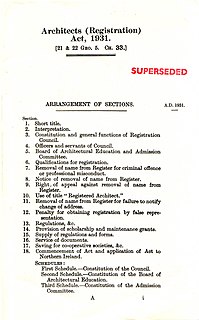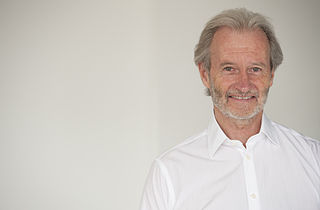This article needs additional citations for verification .(January 2016) (Learn how and when to remove this template message) |
The Society of Architects was formed in 1834 and continued until 1925. At that time Fellows and Associates comprised two distinct classes of membership of the Royal Institute of British Architects (RIBA). They were respectively entitled to use the post-nominal affix "FRIBA" or "ARIBA". The formation of the Society of Architects was a result of a campaign by a group of Associates to be allowed to vote on the affairs of the Institute which the Fellowship class had resisted. [1]

The Royal Institute of British Architects (RIBA) is a professional body for architects primarily in the United Kingdom, but also internationally, founded for the advancement of architecture under its charter granted in 1837 and Supplemental Charter granted in 1971.
In the course of events (see Chronology in Architects Registration in the United Kingdom) which resulted in the passing of the Architects (Registration) Act, 1931, a body was formed called the Architects Registration Bill Committee. Bills for statutory registration of architects which this Committee put forward in 1889 and 1891 were strongly supported by the Society of Architects. In 1902 the Committee and the Society of Architects joined forces as a joint Registration Committee.

The Architects (Registration) Acts, 1931 to 1938 is the statutory citation for three Acts of the United Kingdom Parliament, namely:
In 1905 the RIBA formed a new class for Licentiate members, for whom the post-nominal affix was "LRIBA" This class was for architects who could show evidence of competence, without examinations. When the class was closed in 1913, over 2,000 had been accepted.
In 1925, an increase in the numerical strength of the RIBA was effected when the Society of Architects amalgamated and most of the Society's members transferred to the Licenciate class, which had been reopened. But at about the same time the Incorporated Association of Architects and Surveyors (IAAS) was formed, which opposed a draft bill presented to Parliament in 1927 by the RIBA Registration Committee.
When eventually the Architects' Registration Council of the United Kingdom (ARCUK) came to be established under the Architects (Registration) Act, 1931 with the duty of setting up, maintaining and publishing the Register of Architects, the First Schedule of the Act prescribed that the Councils of certain bodies would be entitled to appoint one member in respect of 500 of their own members; and in the case of the RIBA and the IAAS, this was to be in respect of their own fellows, associates or licentiates.
Under an Act passed by the UK Parliament in 1931, there was established an Architects' Registration Council of the United Kingdom (ARCUK), referred to in the Act as "the Council". The constitution of the Council was prescribed by the First Schedule to the Act. The Act made the Council a body corporate by the name Architects' Registration Council of the United Kingdom. It was habitually referred to colloquially by the acronym ARCUK.
From 1932 there has been a statutory Register of Architects under legislation of the United Kingdom Parliament originally enacted in 1931. The originating Act contained ancillary provisions for entering an architect’s name in the register and removing a name from it which later legislation has amended. The 1931 Act gave it the name “the Register of Registered Architects”, but by an Act of 1938 the name was changed to “the Register of Architects”.



